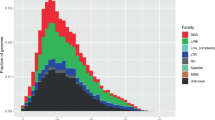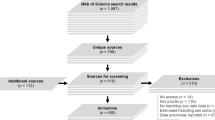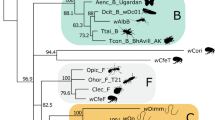Abstract
In the terrestrial isopod Armadillidium vulgare, many females produce progenies with female-biased sex ratios due to two feminizing sex ratio distorters (SRD): Wolbachia endosymbionts and a nuclear non-mendelian locus called the f element. To investigate the potential impact of these SRD on the evolution of host sex determination, we analyzed their temporal distribution in six A. vulgare populations sampled between 2003 and 2017, for a total of 29 time points. SRD distribution was heterogeneous among populations despite their close geographic locations, so that when one SRD was frequent in a population, the other SRD was rare. In contrast with spatial heterogeneity, our results overall did not reveal substantial temporal variability in SRD prevalence within populations, suggesting equilibria in SRD evolutionary dynamics may have been reached or nearly so. Temporal stability was also generally reflected in mitochondrial and nuclear variation. Nevertheless, in a population, a Wolbachia strain replacement coincided with changes in mitochondrial composition but no change in nuclear composition, thus constituting a typical example of mitochondrial sweep caused by endosymbiont rise in frequency. Rare incongruence between Wolbachia strains and mitochondrial haplotypes suggested the occurrence of intraspecific horizontal transmission, making it a biologically relevant parameter for Wolbachia evolutionary dynamics in A. vulgare. Overall, our results provide an empirical basis for future studies on SRD evolutionary dynamics in the context of multiple sex determination factors co-existing within a single species, to ultimately evaluate the impact of SRD on the evolution of host sex determination mechanisms and sex chromosomes.
This is a preview of subscription content, access via your institution
Access options
Subscribe to this journal
Receive 12 print issues and online access
$259.00 per year
only $21.58 per issue
Buy this article
- Purchase on SpringerLink
- Instant access to full article PDF
Prices may be subject to local taxes which are calculated during checkout






Similar content being viewed by others
Data availability
Mitotypes are available in GenBank under accession numbers OR074129 to OR074131. All other data are provided in the supplementary information.
References
Badawi M, Giraud I, Vavre F, Grève P, Cordaux R (2014) Signs of neutralization in a redundant gene involved in homologous recombination in Wolbachia endosymbionts. Genome Biol Evol 6:2654–2664
Becking T, Chebbi MA, Giraud I, Moumen B, Laverré T, Caubet Y et al. (2019) Sex chromosomes control vertical transmission of feminizing Wolbachia symbionts in an isopod. PLOS Biol 17:e3000438
Becking T, Giraud I, Raimond M, Moumen B, Chandler C, Cordaux R et al. (2017) Diversity and evolution of sex determination systems in terrestrial isopods. Sci Rep 7:1–14
Beukeboom LW, Perrin N (2014) The evolution of sex determination. Oxford University Press, Oxford
Bolker BM (2008) Ecological models and data in R. Princeton University Press: Princeton and Oxford.
Bouchon D, Rigaud T, Juchault P (1998) Evidence for widespread Wolbachia infection in isopod crustaceans: molecular identification and host feminization. Proc Biol Sci 265:1081–1090
Braig HR, Zhou WG, Dobson SL, O’Neill SL (1998) Cloning and characterization of a gene encoding the major surface protein of the bacterial endosymbiont Wolbachia pipientis. J Bacteriol 180:2373–2378
Burt A, Trivers R (2006) Genes in conflict. The Belknap Press of Harvard University Press: Cambridge, Massachusetts.
Carrington LB, Lipkowitz JR, Hoffmann AA, Turelli M (2011) A re-examination of Wolbachia-induced cytoplasmic incompatibility in California Drosophila simulans. PloS One 6:e22565
Charlat S, Hornett EA, Fullard JH, Davies N, Roderick GK, Wedell N et al. (2007) Extraordinary flux in sex ratio. Science 317:214
Chebbi MA, Becking T, Moumen B, Giraud I, Gilbert C, Peccoud J et al. (2019) The genome of armadillidium vulgare (Crustacea, Isopoda) provides insights into sex chromosome evolution in the context of cytoplasmic sex determination. Mol Biol Evol 36:727–741
Cordaux R, Bouchon D, Greve P (2011) The impact of endosymbionts on the evolution of host sex-determination mechanisms. Trends Genet 27:332–341
Cordaux R, Chebbi MA, Giraud I, Pleydell DRJ, Peccoud J (2021) Characterization of a sex-determining region and its genomic context via statistical estimates of haplotype frequencies in daughters and sons sequenced in pools. Genome Biol Evol 13:evab121
Cordaux R, Gilbert C (2017) Evolutionary significance of wolbachia-to-animal horizontal gene transfer: female sex determination and the f element in the isopod armadillidium vulgare. Genes 8:186
Cordaux R, Michel Salzat A, Bouchon D (2001) Wolbachia infection in crustaceans: novel hosts and potential routes for horizontal transmission. J Evol Biol 14:237–243
Cordaux R, Michel-Salzat A, Frelon-Raimond M, Rigaud T, Bouchon D (2004) Evidence for a new feminizing Wolbachia strain in the isopod Armadillidium vulgare: evolutionary implications. Heredity 93:78–84
Cordaux R, Pichon S, Hatira HB, Doublet V, Greve P, Marcade I et al. (2012) Widespread Wolbachia infection in terrestrial isopods and other crustaceans. Zookeys 176:123–131
Crawley MJ (2012) The R book. John Wiley & Sons, Ltd: Chichester.
Dąbrowski MJ, Pilot M, Kruczyk M, Żmihorski M, Umer HM, Gliwicz J (2014) Reliability assessment of null allele detection: inconsistencies between and within different methods. Mol Ecol Resour 14:361–373
Durand S, Cohas A, Braquart-Varnier C, Beltran-Bech S (2017) Paternity success depends on male genetic characteristics in the terrestrial isopod Armadillidium vulgare. Behav Ecol Sociobiol 71:90
Durand S, Grandjean F, Giraud I, Cordaux R, Beltran-Bech S, Bech N (2019) Fine-scale population structure analysis in Armadillidium vulgare (Isopoda: Oniscidea) reveals strong female philopatry. Acta Oecol 101
Durand S, Lheraud B, Giraud I, Bech N, Grandjean F, Rigaud T et al. (2023) Heterogeneous distribution of sex ratio distorters in natural populations of the isopod Armadillidium vulgare. Biol Lett 19:20220457
Earl DA, vonHoldt BM (2012) STRUCTURE HARVESTER: a website and program for visualizing STRUCTURE output and implementing the Evanno method. Conserv Genet Resour 4:359–361
Evanno G, Regnaut S, Goudet J (2005) Detecting the number of clusters of individuals using the software structure: a simulation study. Mol Ecol 14:2611–2620
Folmer O, Black M, Hoeh W, Lutz R, Vrijenhoek R (1994) DNA primers for amplification of mitochondrial cytochrome c oxidase subunit I from diverse metazoan invertebrates. Mol Mar Biol Biotechnol 3:294–299
Galtier N, Nabholz B, Glémin S, Hurst GDD (2009) Mitochondrial DNA as a marker of molecular diversity: a reappraisal. Mol Ecol 18:4541–4550
Giraud I, Valette V, Bech N, Grandjean F, Cordaux R (2013) Isolation and characterization of microsatellite loci for the isopod crustacean Armadillidium vulgare and transferability in terrestrial isopods. Plos One 8:e76639
Goudet (2001) FSTAT, a program to estimate and test gene diversities and fixation indices, version 2.9.3. http://www2.unil.ch/popgen/softwares/fstat.htm
Hassan SSM, Idris E, Majerus MEN (2013) Male-killer dynamics in the tropical butterfly acraea encedon (Lepidoptera: Nymphalidae). Afr Entomol 21:209–214
Hatcher MJ (2000) Persistence of selfish genetic elements: population structure and conflict. Trends Ecol Evol 15:271–277
Heath BD, Butcher RDJ, Whitfield WGF, Hubbard SF (1999) Horizontal transfer of Wolbachia between phylogenetically distant insect species by a naturally occurring mechanism. Curr Biol 9:313–316
Helleu Q, Courret C, Ogereau D, Burnham KL, Chaminade N, Chakir M et al. (2019) Sex-ratio meiotic drive shapes the evolution of the Y chromosome in drosophila simulans. Mol Biol Evol 36:2668–2681
Himler AG, Adachi-Hagimori T, Bergen JE, Kozuch A, Kelly SE, Tabashnik BE et al. (2011) Rapid spread of a bacterial symbiont in an invasive whitefly is driven by fitness benefits and female bias. Science 332:254–256
Hornett EA, Charlat S, Wedell N, Jiggins CD, Hurst GDD (2009) Rapidly shifting sex ratio across a species range. Curr Biol CB 19:1628–1631
Hurst GDD, Frost CL (2015) Reproductive parasitism: maternally inherited symbionts in a biparental world. Cold Spring Harb Perspect Biol 7:a017699
Jombart T (2008) adegenet: a R package for the multivariate analysis of genetic markers. Bioinformatics 24:1403–1405
Jombart T, Devillard S, Balloux F (2010) Discriminant analysis of principal components: a new method for the analysis of genetically structured populations. BMC Genet 11:94
Juchault P, Legrand JJ (1972) Croisement de néo-mâles experimentaux chez Armadillidium vulgare Latr. (Crustace, Isopode, Oniscoide). Mise en evidence d’une hétérogamétie femelle. C R Acad Sci Paris 274:1387–1389
Juchault P, Mocquard JP (1993) Transfer of a parasitic sex factor to the nuclear genome of the host: A hypothesis on the evolution of sex-determining mechanisms in the terrestrial isopod Armadillidium vulgare Latr. J Evol Biol 6:511–528
Juchault P, Rigaud T (1995) Evidence for female heterogamety in two terrestrial crustaceans and the problem of sex chromosome evolution in isopods. Heredity 75:466–471
Juchault P, Rigaud T, Mocquard J-P (1992) Evolution of sex-determining mechanisms in a wild population of Armadillidium vulgare Latr. (Crustacea, Isopod): competition between two feminizing parasitic sex factors. Heredity 69:382–390
Juchault P, Rigaud T, Mocquard J-P (1993) Evolution of sex determination and sex ratio variability in wild populations of Armadillidium vulgare (Latr.) (Crustacea, Isopoda): a case study in conflict resolution. Acta Oecologica 14:547–562
Kageyama D, Narita S, Konagaya T, Miyata MN, Abe J, Mitsuhashi W, et al. (2020) Persistence of a Wolbachia-driven sex ratio bias in an island population of Eurema butterflies. 2020.03.24.005017
Kalinowski ST, Taper ML (2006) Maximum likelihood estimation of the frequency of null alleles at microsatellite loci. Conserv Genet 7:991–995
Kalinowski ST, Taper ML, Marshall TC (2007) Revising how the computer program cervus accommodates genotyping error increases success in paternity assignment. Mol Ecol 16:1099–1106
Kaur R, Shropshire JD, Cross KL, Leigh B, Mansueto AJ, Stewart V et al. (2021) Living in the endosymbiotic world of Wolbachia: a centennial review. Cell Host Microbe 29:879–893
Kocher TD, Thomas WK, Meyer A, Edwards SV, Paabo S, Villablanca FX et al. (1989) Dynamics of mitochondrial-DNA evolution in animals: amplification and sequencing with conserved primers. Proc Natl Acad Sci USA 86:6196–6200
Le Clec’h W, Chevalier FD, Genty L, Bertaux J, Bouchon D, Sicard M (2013) Cannibalism and predation as paths for horizontal passage of Wolbachia between terrestrial isopods. PLoS One 8:e60232
Leclercq SB, Thézé J, Chebbi MA, Giraud I, Moumen B, Ernenwein L et al. (2016) Birth of a W sex chromosome by horizontal transfer of Wolbachia bacterial symbiont genome. Proc Natl Acad Sci USA 113:15036–15041
Legrand JJ, Juchault P (1984) Nouvelles données sur le déterminisme génétique et épigénétique de la monogénie chez le crustacés isopodes terrestres Armadillidium vulgare Latr. Génét Sél Evol 16:57–84
Martin G, Juchault P, Legrand JJ (1973) Mise en évidence d’un micro-organisme intracytoplasmique symbiote de l’Oniscoide Armadillidium vulgare L. dont la présence accompagne l’intersexualité ou la féminisation totale des mâles génétiques de la lignée thélygène. Comptes Rendus Académie Sci Paris 276:2313–2316
Meirmans PG (2012) The trouble with isolation by distance. Mol Ecol 21:2839–2846
Miyata M, Nomura M, Kageyama D (2024) Rapid spread of a vertically transmitted symbiont induces drastic shifts in butterfly sex ratio. Curr Biol 34:R490–R492
O’Neill SL, Giordano R, Colbert AM, Karr TL, Robertson HM (1992) 16S rRNA phylogenetic analysis of the bacterial endosymbionts associated with cytoplasmic incompatibility in insects. Proc Natl Acad Sci USA 89:2699–2702
Paradis E (2010) pegas: an R package for population genetics with an integrated–modular approach. Bioinformatics 26:419–420
Peakall R, Smouse PE (2006) genalex 6: genetic analysis in Excel. Popul Genet Softw Teach Res Mol Ecol Notes 6:288–295
Pritchard JK, Stephens M, Donnelly P (2000) Inference of population structure using multilocus genotype data. Genetics 155:945
Rigaud T (1997) Inherited microorganisms and sex determination of arthropod hosts. In: O’Neill SL, Hoffmann AA, Werren JH (eds) Influential passengers: inherited microorganisms and arthropod reproduction, Oxford Univ. Press: Oxford, pp 81–101
Rigaud T, Juchault P (1993) Conflict between feminizing sex ratio distorters and an autosomal masculinizing gene in the terrestrial isopod Armadillidium vulgare Latr. Genetics 133:247–252
Rigaud T, Juchault P (1995) Success and failure of horizontal transfers of feminizing Wolbachia endosymbionts in woodlice. J Evol Biol 8:249–255
Rigaud T, Juchault P, Mocquard JP (1997) The evolution of sex determination in isopods crustaceans. Bioessays 19:409–416
Rigaud T, Moreau M (2004) A cost of Wolbachia-induced sex reversal and female-biased sex ratios: decrease in female fertility after sperm depletion in a terrestrial isopod. Proc R Soc B-Biol Sci 271:1941–1946
Rigaud T, Souty Grosset C, Raimond R, Mocquard JP, Juchault P (1991) Feminizing endocytobiosis in the terrestrial crustacean Armadillidium vulgare Latr. (Isopoda): recent acquisitions. Endocytobiosis Cell Res 7:259–273
Rosenberg NA (2003) DISTRUCT: a program for the graphical display of population structure. Mol Ecol Notes 4:137–138
Rousset F (2008) GENEPOP’007: a complete re-implementation of the GENEPOP software for Windows and Linux. Mol Ecol Resour 8:103–106
Russell A, Borrelli S, Fontana R, Laricchiuta J, Pascar J, Becking T et al. (2021) Evolutionary transition to XY sex chromosomes associated with Y-linked duplication of a male hormone gene in a terrestrial isopod. Heredity 127:266–277
Taylor DR (1990) Evolutionary consequences of cytoplasmic sex ratio distorters. Evol Ecol 4:235–248
Turelli M, Hoffmann AA (1991) Rapid spread of an inherited incompatibility factor in California Drosophila. Nature 353:440–442
Van Oosterhout C, Hutchinson WF, Wills DPM, Shipley P (2004) Micro-checker: software for identifying and correcting genotyping errors in microsatellite data. Mol Ecol Notes 4:535–538
Vavre F, Fleury F, Lepetit D, Fouillet P, Boulétreau M (1999) Phylogenetic evidence for horizontal transmission of Wolbachia in host-parasitoid associations. Mol Biol Evol 16:1711–1723
Verne S, Johnson M, Bouchon D, Grandjean F (2007) Evidence for recombination between feminizing Wolbachia in the isopod genus Armadillidium. Gene 397:58–66
Verne S, Johnson M, Bouchon D, Grandjean F (2012) Effects of parasitic sex-ratio distorters on host genetic structure in the Armadillidium vulgare-Wolbachia association. J Evol Biol 25:264–276
Verne S, Puillandre N, Brunet G, Gouin N, Samollow PB, Anderson JD et al. (2006) Characterization of polymorphic microsatellite loci in the terrestrial isopod Armadillidium vulgare. Mol Ecol Notes 6:328–330
Weeks AR, Turelli M, Harcombe WR, Reynolds KT, Hoffmann AA (2007) From parasite to mutualist: rapid evolution of Wolbachia in natural populations of Drosophila. PLoS Biol 5:e114
Weir BS, Cockerham CC (1984) Estimating F-statistics for the analysis of population structure. Evolution 38:1358–1370
Werren JH (2011) Selfish genetic elements, genetic conflict, and evolutionary innovation. Proc Natl Acad Sci USA 108(2):10863–10870
Werren JH, Baldo L, Clark ME (2008) Wolbachia: master manipulators of invertebrate biology. Nat Rev Microbiol 6:741–751
Werren JH, Zhang W, Guo LR (1995) Evolution and phylogeny of Wolbachia: reproductive parasites of arthropods. Proc Biol Sci 261:55–63
Wickham H, Chang W, Henry L, Pedersen TL, Takahashi K, Wilke C, et al. (2020) ggplot2: Create Elegant Data Visualisations Using the Grammar of Graphics. https://ggplot2.tidyverse.org/index.html
Acknowledgements
We thank Sébastien Verne and Victorien Valette for assistance with sample collection. This work was funded by Agence Nationale de la Recherche Grants ANR-15-CE32-0006 (CytoSexDet) to RC and TR, and ANR-20-CE02-0004 (SymChroSex) to JP, and intramural funds from the CNRS and the University of Poitiers.
Author information
Authors and Affiliations
Contributions
RC, JP and TR designed the experiments. FG, NB and JP sampled populations. SD, IG and AL performed laboratory work. SD, RP and NB performed data analyses. RC and SD wrote the first draft of the manuscript. TR, JP, NB, RP and FG amended the manuscript.
Corresponding author
Ethics declarations
Competing interests
The authors declare no competing interests.
Ethics approval
No specific permission was required for sampling the populations from Beauvoir, Chizé, Gript and La Crèche because they were located in public areas. Populations from Coulombiers and Poitiers were sampled on private lands after the land owners gave permission to conduct sampling on the sites.
Additional information
Publisher’s note Springer Nature remains neutral with regard to jurisdictional claims in published maps and institutional affiliations.
Associate editor: Louise Johnson
Supplementary information
Rights and permissions
Springer Nature or its licensor (e.g. a society or other partner) holds exclusive rights to this article under a publishing agreement with the author(s) or other rightsholder(s); author self-archiving of the accepted manuscript version of this article is solely governed by the terms of such publishing agreement and applicable law.
About this article
Cite this article
Durand, S., Pigeault, R., Giraud, I. et al. Temporal stability of sex ratio distorter prevalence in natural populations of the isopod Armadillidium vulgare. Heredity 133, 287–297 (2024). https://doi.org/10.1038/s41437-024-00713-1
Received:
Revised:
Accepted:
Published:
Issue date:
DOI: https://doi.org/10.1038/s41437-024-00713-1



